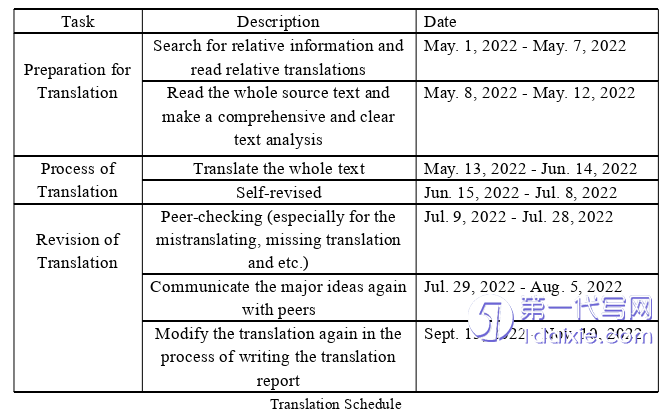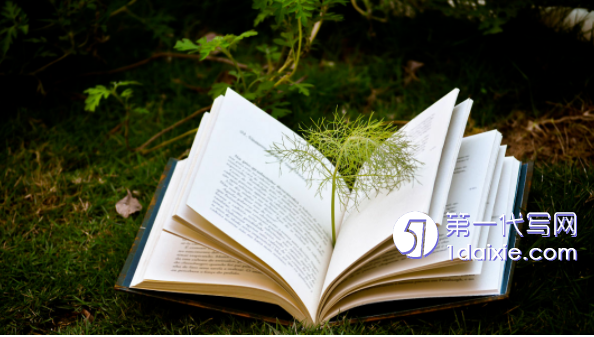本文是一篇英语毕业论文,本报告通过分析例句中的语法衔接手段,在目的论的指导下,采用了语境化,重复,增译和省译四种翻译方法来提高译文的连贯性,以期为同类语篇中语法衔接手段的翻译提供参考。
1 Task Description
1.1 Background of the Task

Written by Michiel Roscam Abbing,Plastic Soup:An Atlas of Ocean Pollutionwas published in English in 2019 by Island Press,focusing on plastic pollution in theocean and measures to combat it,which is closely related to our life.
Covering 72 percent of the earth’s surface,the ocean is our main source of oxygen.The ocean is home to marine species and the habitat in the world and they need just asmuch protection as our land.However,nowadays,plastic dominates our lives.Not onlydoes it exist in the land where we live,plastic pollution also exists in the ocean where welive nearby.Unfortunately,the United Nations Environment Programme(UNEP)believesplastic wastes and microplastics have been becoming one of the biggest environmentproblems faced by the humans in the world.Considering that ocean is the second livingenvironment of mankind,devoting to the marine conservation has become the commonresponsibility of all mankind.
The selected text is a book,mainly writing for teenagers,which illustrates plasticpollution in the ocean and aims to raise people’s awareness of environmental protection.
1.2 Choice of the Text
The choice of this text is significant both practically and academically.
On one hand,the translation of books about environmental protection is of greatpractical significance.In a time-frame shorter than the average human lifespan,plasticsoup has become a staple on the life menu.The rapidly growing global population doesnot know what to do with this marvellous material.Our living condition-earth,is beingpolluted at an unprecedented rate and humanity must solve the problem together.If wefail to do so,we will be saddling future generations with a problem that will haunt them.Plastic is notoriously insoluble and cannot be digested by animals,which is fatal tomarine organism.As we all know,people are at the top of the food chain,and the toxinsthat accumulate along the food chain eventually act on us.So the translation of popularscience text on marine litter can provide more intuitive perspectives for people to realizethe ocean issues,which is of great practical significance for the protection of our indirectliving environment.
In addition,with the teenagers as its target readers,conforming to the educationalconcept that the best education begins with the child,this book is of great educationalsignificance to broaden young people’s horizon and raise their awareness of environmental protection.Just as the maintenance of the environment depends on thegovernment completely,so does everyone in society,especially teenagers.
2 Process Description
2.1 Preparation for Translation
At the beginning of the translation,the translator has collected a great deal ofinformation including different text types,as well as the linguistic characteristics ofdifferent texts,and the theoretical knowledge of translation.
In the first place,the translator and his partner choose foreign books together,andunder the guidance of their supervisor,they decide to translate the same book together.After a week,Plastic Soup:An Atlas of Ocean Pollution was chosen as the translationmaterial.
What follows is to check whether the chosen book is translated into Chinesethrough various websites.After ensuring that there is no official Chinese version,translator began to search for information about this book including the author,text type,linguistic characteristics,target readers,as well as the intention of the original author.Because the translator is responsible for the translation of six to ten chapters,so beforethe translation,in order to ensure the complete understanding of the source text,theauthor had read through the whole book,with focus on chapter six to ten,and read thepreface and conclusion of the bibliography to have the overall idea of the original book.
2.2 Process of Translation
After understanding the original text in the pre-translation preparation,thetranslator enters the translation stage.
To accomplish the whole translation practice effectively,the translator first countedthe number of words in the translated material and made a detailed schedule according tohis translation ability.First of all,the translator read through the book again in order tohave an accurate understanding of the translated material before actually writing thetranslation.This preparation process took about two weeks,from May 1,2022 to May 13,2022,in which the translator read some parallel texts and relative translations so that acomprehensive and clear text analysis came to the translator.
Then,the translator began translating the original text.The translation process was divided into two parts including the first round translation,which taking about one monthfrom May 13,2022 to June 14,2022,and the second round translation,also calledself-revised,which taking about 20 days,from June 15,2022 to July 5,2022.In the firstround translation,the translator used Google Translate and deep L translation tool totranslate the full text.With the help of machine-aided translation tool,during thetranslation process,the translator highlighted sentences in the original text that were lesslogical.In the second translation,the translator revised the first version again from theperspective of textual coherence.For the difficult sentences marked in the first round oftranslation,the translator carried out targeted research and analysis,and summarized thetranslation with more clear logic.
3 Case Analysis ..................... 10
3.1 Theoretical Framework ......................... 10
3.1.1 Introduction to Skopos Theory ............................ 11
3.1.2 Rules of the Skopos Theory ......................... 12
4 Conclusion ............................... 40
4.1 Major Findings ...................... 40
4.2 Limitations ......................................... 41
4.3 Suggestions ............................... 42
3 Case Analysis
3.1 Theoretical Framework

As it is mentioned above,the original book is writing for teenagers,so it brings thetranslation some requirements that the translation should not only convey the originalauthor’s writing intention accurately,but also adapt the target language to teenagers,so asto realize the appeal of popular science texts as much as possible.Furthermore,in theframework of Vermeer’s Skopos theory,one of the most important factors determiningthe purpose of translation is the audience-the recipient of the translation.Therefore,combining the above two points,Skopos theory is chosen as the translation guidancetheory for this practice report.
3.1.1 Introduction to Skopos Theory
The Skopos theory,a classic translation theory,was proposed by Germantranslation theorists Hans Vermeer in the late 1970s.Skopos theory applies the concept of“Skopos”to translation.Skopos,derived from the Greek,is synonymous with“purpose”and it is the core concept of the Skopos theory and plays a major role in the translationprocess.
In the 1970s,functional translation theory was developed in Germany.Then,in1978,Hans Vermeer proposed the Skopos theory that would free translation studies fromthe constraints of prose.In this theory,based on the original sentence,translation isregarded as a purposeful and fruitful act,which must be completed through discussion.Translation must follow a series of rules,and the first rule is the Skopos rule(Vermeer,1989).In other words,translation depends on the purpose of translation,and translatorsneed to adopt corresponding translation strategies according to different translationpurposes(Nord,2001).
4 Conclusion
4.1 Major Findings
The selected text(expert)named Plastic Soup:An Atlas of Ocean Pollutionincludes a lot of cohesive devices especially the grammatical cohesion.After translatingthe translation practice,the translator further studies the grammatical cohesion and theSkopos theory which is used to guide the translation.In this report,the most importantthing is to classify the classification of grammatical cohesion and study the propertranslation methods to address the translation difficulties.During the translation,severaltranslation methods are adopted to addressing the translation difficulties of grammaticalcohesion,which involves the contextualization,repetition,addition and omission.Withthese translation methods,the target language is read with strong coherence andreadability.
When translating the reference,the translator should consider the whole paragraphto ensure the true meaning of the special words or expression.So when translatorencounters the reference,contextualization translation methods was adopted.Only thewhole context was considered,the target language will become more understandable.Inaddition,when encountering the substitution,the translation methods repetition couldhelp the reader understand the source language more clearly.In this way,the specific meaning is repeated with the same expression involved in the related text.If thissubstitution wasn’t cleared,readers may misunderstand or the target language may beunreadable.What’s more,when the translator encounter conjunction,addition andomission could be adopted.Sometimes literal translation will make the translation appearrigid,and the language of the translation will not be smooth,which will affect thecoherence of the translation and thus affect the quality of the translation.Therefore,in thetranslation process of connection,the translation quality should be improved by properuse of additional translation and spare translation.
reference(omitted)
